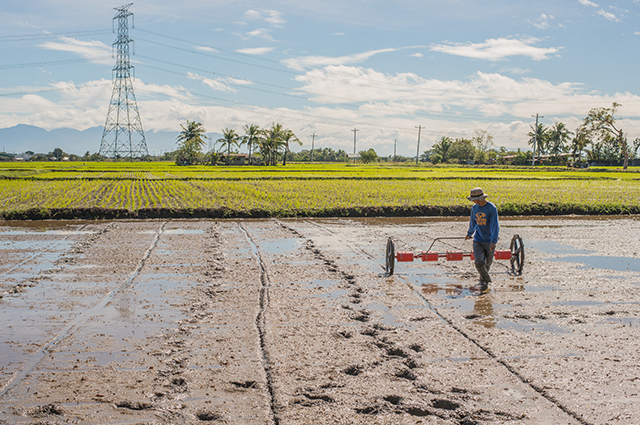 The direct seeding, a crop establishment method where pre-germinated seeds are sown directly onto the soil surface, can help address high labor cost in rice farming according to experts.
The direct seeding, a crop establishment method where pre-germinated seeds are sown directly onto the soil surface, can help address high labor cost in rice farming according to experts.
PhilRice Agronomist Myrna D. Malabayabas said that the method can be done either by dry or wet seeding and does not require seedbed preparation.
“The dry direct-seeding method is more commonly used in rainfed and upland areas. It involves sowing of pre-germinated seeds on dry soil surface and then incorporating the seeds either by ploughing or harrowing. Wet direct-seeding, on the other hand, is practiced during dry and wet seasons in irrigated and rainfed areas. It is done either through broadcasting or drilling pre-germinated seeds with the use of a drum-seeder on a wet, well-leveled paddy,” Malabayabas explained.
Direct-seeded rice matures earlier than transplanted rice. Hence, labor requirements and expenses for crop establishment and the time spent on crop management are reduced.
A PhilRice study titled Benchmarking the Philippine rice economy relative to major rice-producing countries in Asia, says that P4.42 is spent on labor cost for every kilogram of rice on transplanting while P3.28 is spent on direct-seeding.
| Crop establishment method | Labor cost | Labor requirement (1 man-day = 8 hours of work) |
| Direct-seeding | P3.28/kg of rice | 2 man-days/ha |
| Transplanting | P4.42/kg of rice | 25 man-days/ha |
In direct-seeding method, farmers can save up to P1.14 on labor cost for every kilogram of rice they produce and 23-man days for every hectare of their field.
In a seminar titled Direct-seeded Rice: Progress, Prospects, and Challenges at PhilRice on 21 January, Dr. Vethaiya T. Balasubramanian said that managing weeds is one of the challenges in using the direct-seeding method.
The former agronomist at the International Rice Research Institute (IRRI) explained that weeds germinate simultaneously with rice due to the absence of water that suppresses their growth. Nevertheless, options are available to address the problem.
“Among the ways to manage weeds include narrow spacing and uniform plant population, appropriate water depth and timing, use of weed-competitive varieties, and herbicide rotation and combination,” Dr. Balasubramanian said.
Malabayabas added that savings from the labor cost can offset the expenses in weed and pest control.
“When the Integrated Crop Management (ICM) is followed properly, the optimum yield is comparable to that of transplanted method,” she said.
Experts at PhilRice recommend varieties for the direct-seeding method. These varieties are early maturing, resistant to drought, and can attain a maximum yield of at least 6 t/ha.
| Recommendation Varieties | Days of Maturity | Maximum Yield |
| NSIC Rc272 (Sahod Ulan 2) | 110 DAS (days after sowing) | 6.4 t/ha |
| NSIC Rc348 (Sahod Ulan 12) | 103 DAS | 5 t/ha |
| NSIC Rc346 (Sahod Ulan 11) | 105 DAS | 6.2 t/ha |
For more information about the direct-seeding technology, call or text PhilRice Text Center 0920-911-1398 or email prri.mail@philrice.gov.ph.




